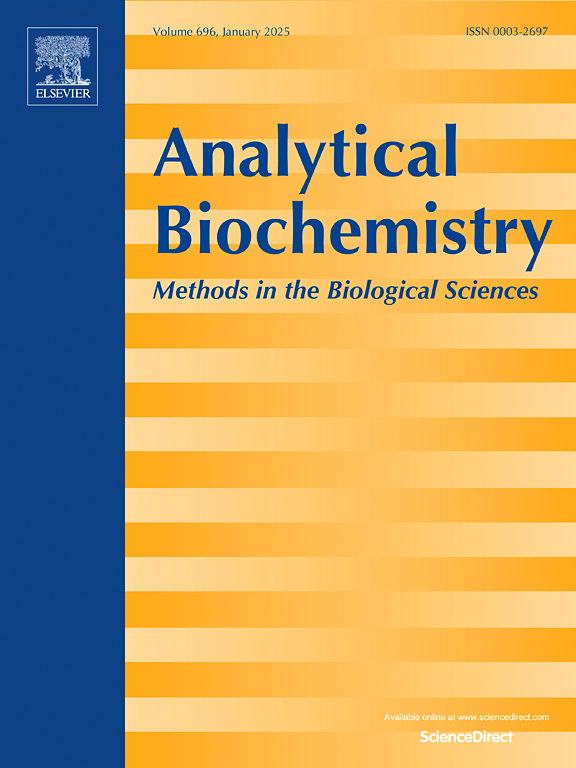Flower-like biomimetic enzyme for rapid and sensitive detection of zearalenone in vegetable oil deodorizer distillate
IF 2.6
4区 生物学
Q2 BIOCHEMICAL RESEARCH METHODS
引用次数: 0
Abstract
In order to achieve high quality production of vitamin E and plant sterols, it is necessary to conduct rapid and accurate detection of fungal toxins in their production raw material (vegetable oil deodorizer distillate, VODD). In this study, the flower-like biomimetic enzyme of silver-doped ZnO was synthesized through wet chemical method and in-situ reduction method. Based on above work, a flower-like biomimetic enzyme modified glass carbon electrode was fabricated, and its excellent detection capability against fungal toxins zearalenone was confirmed through electrochemical analysis. The detection limit was 8 ng mL−1, with a linear range of 40 ng mL−1-25 μg mL−1. Simultaneously, the biomimetic enzyme sensor takes only 10 min from preparation to completion of detection, and the RSD between the 7 repeated test results was only 0.612 %. After seven days of storage, the current response value remains 91.5 % of the initial value. In practical applications, the recovery rate of zearalenone in VODD using this sensor ranged from 98.1 % to 102.08 %, yielding satisfactory results. Therefore, the novel flower-like biomimetic enzyme represents an ideal choice for developing zearalenone sensors and holds promising prospects for wide application in fungal toxins analysis.

植物油脱臭馏出物中玉米赤霉烯酮的快速灵敏检测花卉仿生酶。
为了实现维生素E和植物甾醇的高质量生产,有必要对其生产原料(植物油脱臭馏出物,VODD)中的真菌毒素进行快速准确的检测。本研究通过湿化学法和原位还原法合成了银掺杂ZnO的花状仿生酶。在此基础上,制备了仿花型仿生酶修饰玻璃碳电极,并通过电化学分析证实了其对真菌毒素玉米赤霉烯酮的良好检测能力。检出限为8 ng mL-1,线性范围为40 ng mL-1 ~ 25 μ mL-1。同时,仿生酶传感器从制备到完成检测仅需10分钟,7次重复检测结果的RSD仅为0.612%。存储7天后,当前响应值仍为初始值的91.5%。在实际应用中,利用该传感器对VODD中玉米赤霉烯酮的回收率在98.1% ~ 102.08%之间,取得了满意的结果。因此,这种新型的花状仿生酶是开发玉米赤霉烯酮传感器的理想选择,在真菌毒素分析中具有广阔的应用前景。
本文章由计算机程序翻译,如有差异,请以英文原文为准。
求助全文
约1分钟内获得全文
求助全文
来源期刊

Analytical biochemistry
生物-分析化学
CiteScore
5.70
自引率
0.00%
发文量
283
审稿时长
44 days
期刊介绍:
The journal''s title Analytical Biochemistry: Methods in the Biological Sciences declares its broad scope: methods for the basic biological sciences that include biochemistry, molecular genetics, cell biology, proteomics, immunology, bioinformatics and wherever the frontiers of research take the field.
The emphasis is on methods from the strictly analytical to the more preparative that would include novel approaches to protein purification as well as improvements in cell and organ culture. The actual techniques are equally inclusive ranging from aptamers to zymology.
The journal has been particularly active in:
-Analytical techniques for biological molecules-
Aptamer selection and utilization-
Biosensors-
Chromatography-
Cloning, sequencing and mutagenesis-
Electrochemical methods-
Electrophoresis-
Enzyme characterization methods-
Immunological approaches-
Mass spectrometry of proteins and nucleic acids-
Metabolomics-
Nano level techniques-
Optical spectroscopy in all its forms.
The journal is reluctant to include most drug and strictly clinical studies as there are more suitable publication platforms for these types of papers.
 求助内容:
求助内容: 应助结果提醒方式:
应助结果提醒方式:


